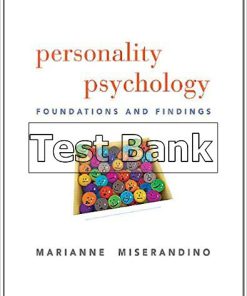Personality Psychology Canadian 1st Edition Larsen Test Bank
You may also like
Personality Psychology Canadian 1st Edition Larsen Test Bank

Product details:
- ISBN-10 : 0205897452
- ISBN-13 : 978-0205897452
- Author: Marianne Miserandino
Personality Psychology: Foundations and Findings is an evidence-based text with integrated cultural references and excellent coverage of the key building blocks of the subject matter–namely, the “foundations”(traits, genetics, self and identity, neuroscience, intrapsychic aspects, regulations and motivation, and cognition as it applies to the human personality) and the “findings” (the cutting edge research in each of these areas in which personality psychologists are actively engaged every day).
Table contents:
- Chapter 1
- Introduction to Personality Psychology
- Personality Defined
- Personality Is the Set of Psychological Traits
- And Mechanisms
- Within the Individual
- That Are Organized and Relatively Enduring
- And That Influence
- The Individual’s Interactions with
- And Adaptations to
- The Environment
- Three Levels of Personality Analysis
- Human Nature
- Individual and Group Differences
- Individual Uniqueness
- A Fissure in the Field
- Grand Theories of Personality
- Contemporary Research in Personality
- Six Domains of Knowledge About Human Nature
- Dispositional Domain
- Biological Domain
- Intrapsychic Domain
- Cognitive-Experiential Domain
- Social and Cultural Domain
- Adjustment Domain
- The Role of Personality Theory
- Standards for Evaluating Personality Theories
- Is There a Grand Ultimate and True Theory of Personality?
- Key Terms
- Chapter 2
- Personality Assessment, Measurement, and Research Design
- Sources of Personality Data
- Self-Report Data ( S-Data)
- Observer-Report Data ( O-Data)
- Test Data ( T-Data)
- Life- Outcome Data (L-Data)
- Issues in Personality Assessment
- Evaluation of Personality Measures
- Reliability
- Validity
- Generalizability
- Research Designs in Personality
- Experimental Methods
- Correlational Studies
- Case Studies
- When to Use Experimental, Correlational, and Case Study Designs
- Summary and Evaluation
- Key Terms
- Part I The Dispositional Domain
- Chapter 3
- Traits and Trait Taxonomies
- What Is a Trait? Two Basic Formulations
- Traits as Internal Causal Properties
- Traits as Purely Descriptive Summaries
- The Act Frequency Formulation of Traits—AnIllustration of the Descriptive Summary Formulation
- Act Frequency Research Program
- Evaluation of the Act Frequency Formulation
- Identification of the Most Important Traits
- Lexical Approach
- Statistical Approach
- Theoretical Approach
- Evaluating the Approaches for Identifying Important Traits
- Taxonomies of Personality
- Eysenck’s Hierarchical Model of Personality
- Circumplex Taxonomies of Personality
- The Five-Factor Model (“Big Five”)
- The HEXACO Model
- Summary and Evaluation
- Key Terms
- Chapter 4
- Theoretical and Measurement Issues in Trait Psychology
- Theoretical Issues
- Meaningful Differences Among Individuals
- Consistency over Time
- Consistency Across Situations
- Person– Situation Interaction
- Aggregation
- Measurement Issues
- Carelessness
- Faking on Questionnaires
- Beware of Barnum Statements in Personality Test Interpretations
- Personality and Prediction
- Applications of Personality Testing in the Workplace
- Legal Issues in Personality Testing in Employment Settings
- Personnel Selection— Choosing the Right Person for the Job
- Selection in Business Settings—The Myers- Briggs Type Indicator
- Selection in Business Settings—The Hogan Personality Inventory
- Summary and Evaluation
- Key Terms
- Chapter 5
- Personality Dispositions over Time: Stability, Coherence, and Change
- Conceptual Issues: Personality Development, Stability, Coherence, and Change
- What Is Personality Development?
- Rank Order Stability
- Mean Level Stability
- Personality Coherence
- Personality Change
- Three Levels of Analysis
- Population Level
- Group Differences Level
- Individual Differences Level
- Personality Stability over Time
- Stability of Temperament During Infancy
- Stability During Childhood
- Rank Order Stability in Adulthood
- Mean Level Stability in Adulthood
- Personality Change
- Changes in Self-Esteem from Adolescence to Adulthood
- Autonomy, Dominance, Leadership, and Ambition
- Sensation Seeking and Impulsivity
- Increasing Openness and Creativity
- Personality Changes Across Cohorts: Assertiveness and Narcissism
- Volitional Personality Change: Is it Possible?
- Personality Coherence over Time: Prediction of Socially Relevant Outcomes
- Marital Stability, Marital Satisfaction, and Divorce
- Alcoholism, Drug Use, and Emotional Disturbance
- Religiousness and Spirituality
- Education, Academic Achievement, and Dropping Out
- Health and Longevity
- Predicting Personality Change
- Summary and Evaluation
- Key Terms
- Part II The Biological Domain Chapter
- Chapter 6
- Genetics and Personality
- The Human Genome
- Controversy About Genes and Personality
- Goals of Behavioural Genetics
- What Is Heritability?
- Misconceptions About Heritability
- Nature–Nurture Debate Clarified
- Behavioural Genetic Methods
- Selective Breeding— Studies of Humans’ Best Friend
- Family Studies
- Twin Studies
- Adoption Studies
- Major Findings from Behavioural Genetic Research
- Personality Traits
- Attitudes and Preferences
- Drinking and Smoking
- Marriage
- Shared versus Nonshared Environmental Influences: A Riddle
- Genes and the Environment
- Genotype–Environment Interaction
- Genotype–Environment Correlation
- Molecular Genetics
- Behavioural Genetics, Science, Politics, and Values
- Summary and Evaluation
- Key Terms
- Chapter 7
- Physiological Approaches to Personality
- A Physiological Approach to Personality
- Physiological Measures Commonly Used in Personality Research
- Electrodermal Activity (Skin Conductance)
- Cardiovascular Activity
- Brain Activity
- Other Measures
- Physiologically Based Theories of Personality
- Extraversion–Introversion
- Sensitivity to Reward and Punishment
- Sensation Seeking
- Neurotransmitters and Personality
- Morningness–Eveningness
- Brain Asymmetry and Affective Style
- Summary and Evaluation
- Key Terms
- Chapter 8
- Evolutionary Perspectives on Personality
- Evolution and Natural Selection
- Natural Selection
- Sexual Selection
- Genes and Inclusive Fitness
- Products of the Evolutionary Process
- Evolutionary Psychology
- Premises of Evolutionary Psychology
- Empirical Testing of Evolutionary Hypotheses
- Human Nature
- Need to Belong
- Helping and Altruism
- Universal Emotions
- Sex Differences
- Sex Differences in Aggression
- Sex Differences in Jealousy
- Sex Differences in Mate Preferences
- Individual Differences
- Environmental Triggers of Individual Differences
- Heritable Individual Differences Contingent on Other Traits
- Frequency–Dependent Strategic Individual Differences
- The Big Five, Motivation, and Evolutionarily Relevant Adaptive Problems
- Limitations of Evolutionary Psychology
- Summary and Evaluation
- Key Terms
- Part III The Intrapsychic Domain
- Chapter 9
- Psychoanalytic Approaches to Personality
- Sigmund Freud: A Brief Biography
- Fundamental Assumptions of Psychoanalytic Theory
- Basic Instincts: Sex and Aggression
- Unconscious Motivation: Sometimes We Don’t Know Why We Do What We Do
- Psychic Determinism: Nothing Happens by Chance
- Structure of Personality
- Id: Reservoir of Psychic Energy
- Ego: Executive of Personality
- Superego: Upholder of Societal Values and Ideals
- Interaction of the Id, Ego, and Superego
- Dynamics of Personality
- Types of Anxiety
- Defence Mechanisms
- Psychosexual Stages of Personality Development
- Personality and Psychoanalysis
- Techniques for Revealing the Unconscious
- The Process of Psychoanalysis
- Why Is Psychoanalysis Important?
- Evaluation of Freud’s Contributions
- Summary and Evaluation
- Key Terms
- Chapter 10
- Psychoanalytic Approaches: Contemporary Issues
- The Neo-Analytic Movement
- Repression and Contemporary Research on Memory
- Contemporary Views on the Unconscious
- Ego Psychology
- Erikson’s Eight Stages of Development
- Karen Horney and a Feminist Interpretation of Psychoanalysis
- Emphasis on Self and the Notion of Narcissism
- Object Relations Theory
- Early Childhood Attachment
- Adult Relationships
- Summary and Evaluation
- Key Terms
- Chapter 11
- Motives and Personality
- Basic Concepts
- Need
- Press
- Apperception and the TAT
- The Big Three Motives: Achievement, Power, and Intimacy
- Need for Achievement
- Need for Power
- Need for Intimacy
- Humanistic Tradition: The Motive to Self- Actualize
- Abraham Maslow’s Contributions
- Carl Rogers’ Contributions
- Summary and Evaluation
- Key Terms
- Part IV The Cognitive/Experiential Domain
- Chapter 12
- Cognitive Topics in Personality
- Personality Revealed Through Perception
- Field Dependence
- Pain Tolerance and Sensation Reducing/ Augmenting
- Personality Revealed Through Interpretation
- Kelly’s Personal Construct Theory
- Locus of Control
- Learned Helplessness
- Personality Revealed Through Goals
- Personal Projects Analysis
- Cognitive Social Learning Theory
- Intelligence
- Summary and Evaluation
- Key Terms
- Chapter 13
- Emotion and Personality
- Issues in Emotion Research
- Emotional States versus Emotional Traits
- Categorical versus Dimensional Approach to Emotion
- Content versus Style of Emotional Life
- Content of Emotional Life
- Style of Emotional Life
- Interaction of Content and Style in Emotional Life
- Summary and Evaluation
- Key Terms
- Chapter 14
- Approaches to the Self
- Descriptive Component of the Self: Self- Concept
- Self- Concept Development
- Self- Schemas: Possible Selves, Ought Selves, and Undesired Selves
- Is There a ” True” Self?
- Evaluative Component of the Self: Self- Esteem
- Evaluation of Oneself
- Research on Self-Esteem
- Social Component of the Self: Social Identity
- The Nature of Identity
- Identity Development
- Identity Crises
- Summary and Evaluation
- Key Terms
- Part V The Social and Cultural Domain
- Chapter 15
- Personality and Social Interaction
- Selection
- Personality Characteristics Desired in a Partner
- Assortative Mating for Personality: The Search for the Similar
- Do People Get the Partners They Want? And Are They Happy?
- Personality and the Selective Breakup of Couples
- Shyness and the Selection of Risky Situations
- Other Personality Traits and the Selection of Situations
- Evocation
- Aggression and the Evocation of Hostility
- Evocation of Anger and Upset in Couples
- Evocation of Likability, Pleasure, and Pain
- Evocation Through Expectancy Confirmation
- Manipulation: Social Influence Tactics
- A Taxonomy of Eleven Tactics of Manipulation
- Personality Predictors of Tactics of Manipulation
- Panning Back: An Overview of Personality and Social Interaction
- Summary and Evaluation
- Key Terms
- Chapter 16
- Sex, Gender, and Personality
- The Science and Politics of Studying Sex and Gender
- History of the Study of Sex Differences
- Calculation of Effect Size: How Large Are the Sex Differences?
- Minimalists and Maximalists
- Sex Differences in Personality
- Temperament in Children
- Five-Factor Model
- Basic Emotions: Frequency and Intensity
- Other Dimensions of Personality
- Masculinity/Femininity, Gender Stereotypes, and Gender Identity
- Masculinity, Femininity, and Androgyny
- Gender Stereotypes
- Gender Identity
- Theories of Sex Differences
- Socialization and Social Roles
- Hormonal Theories
- Evolutionary Psychology Theory
- An Integrated Theoretical Perspective
- Summary and Evaluation
- Key Terms
- Chapter 17
- Culture and Personality
- Cultural Violations: An Illustration
- What Is Cultural Personality Psychology?
- Cultural Differences in Personality
- Evoked Culture
- Transmitted Culture
- Do Cultures Have Distinctive Personality Profiles?
- Cultural Similarities in Personality
- Cultural Universals
- Summary and Evaluation
- Key Terms
- Part VI The Adjustment Domain
- Chapter 18
- Stress, Coping, Adjustment, and Health
- Models of the Personality–Illness Connection
- The Concept of Stress
- The Stress Response
- Major Life Events
- Daily Hassles
- Varieties of Stress
- Primary and Secondary Appraisal
- Coping Strategies and Styles
- Explanatory Style
- Optimism and Health
- Management of Emotions and Disclosure
- Hardiness and Resilience
- Type A Personality and Cardiovascular Disease
- Hostility: The Lethal Component of the Type A Behaviour Pattern
- How the Arteries Are Damaged by Hostile Type A Behaviour
- Summary and Evaluation
- Key Terms
- Chapter 19
- Disorders of Personality
- The Building Blocks of Personality Disorders
- The Concept of Disorder
- What Is Abnormal?
- The Diagnostic and Statistical Manual of Mental Disorders
- What Is a Personality Disorder?
- Specific Personality Disorders
- Cluster A. The Eccentric Cluster: Ways of Being Different
- Cluster B. The Erratic Cluster: Ways of Being Unstable and Emotional
- Cluster C. The Anxious Cluster: Ways of Being Fearful and Distressed
- Prevalence of Personality Disorders
- Gender Differences in Personality Disorders
- Dimensional Model of Personality Disorders
- Causes of Personality Disorders
- Summary and Evaluation
- Key Terms
- Conclusion
- Chapter 20
- Summary and Future Directions
- Current Status of the Field
- Domains of Knowledge: Where We’ve Been, Where We’re Going
- Dispositional Domain
- Biological Domain
- Intrapsychic Domain
- Cognitive/ Experiential Domain
- Social and Cultural Domain
- Adjustment Domain
- Integration: Personality in the Twenty-First Century
- Glossary
- References
- Chapter Sources
- Name Index
- Subject Index
People also search:
personality psychology 1st canadian edition pdf
when did personality psychology begin
is canada good for psychology
famous psychologists canada
a personality psychologist












